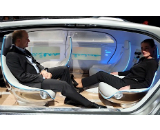The digital dashboard is a gold-rush scramble for territory. There’s money in the dashboard. It’s a place where brand loyalties are formed — traditionally to radio stations, and lately to streaming audio brands. The biggest new players, Google and Apple, are in it for the data ownership, which they can deploy advantageously in other segments of their sprawling businesses.
But what if there were no dashboard at all? Autonomous (self-driving) cars are rolling toward us, and will be on the road sooner or later. Google has been road-testing its autonomous car every day for over a year. How will audio competition be shaped when the car is a WiFi-connected living room?
Touching the Brakes
We’re getting ahead of ourselves, admittedly. The challenge of putting autonomous cars on the road is larger than technology hurdles. Even if safety is proven, there are regulatory unknowns, liability quagmires in accident scenarios, and general mistrust among skeptical consumers. When I mentioned self-driving cars to my wife, she said, “My computer doesn’t work right. Why would I trust a car?”
Digital dashboards and connected cars have been a growing presence at CES for several years, and their collective footprint this year is a record. Ten automakers are occupying space on the colossal CES exhibit floor. Ford, the first company to venture into the leading geek-tech conference in 2007, is showing five cars in a two-story showcase. Execs from Mercedes-Benz, Ford, and GM will give keynote speeches.
Not all digital dashboard innovations are about audio and “infotainment” — the convenient buzzword for all kinds of in-car radio, traditional and online. GM will announce this week an expansion of its OnStar connected system, stepping beyond safety values to … shopping. (I mentioned money in the dashboard, right?) OnStar representatives will provide live information about special deals at participating merchants near the car’s location.
Visions
But the most startling and forward-looking presentations at CES (so far) are self-driving cars. Not all the presentations are formal — Ford CEO Mark Fields told a dinner meeting of investors last night in Vegas: “Probably, in the next five years, you’ll see somebody introduce autonomous vehicles.” (Unhappy news for my wife.)
Mercedes-Benz put its product where its mouth is, bringing a conceptual self-driving car to the CES floor. Called the F015 Luxury in Motion, it is a design concept, not a road-ready autonomous car. Interestingly, the seats face each other, living room style.
If that is the conceptual future, and if it’s coming soon, will it usurp the current gold rush onto digital dashboards? (I’m reminded of CD-ROMs, touted as essential media distribution in the early 1990s, and knocked out of the picture by the web. And skeptics should keep in mind that nobody predicted the web would grow as it did in five years.)
Infotainment controls will still be necessary in self-driving cars. But the F015 concept is more like a living room or office than a car of today. Perhaps the driver’s personal controls — mobile devices, mainly smartphones today — will assert absolute control in the autonomous car. They are largely in control now, even as automakers accelerate their tech development cycles to accommodate consumer expectation of connectivity. If you don’t need to look at the road, you might as well be looking at your personal screens — which too many drivers are doing anyway.
Prediction
I’ll make one specific prediction. In a self-driving car, branded content will thrive; branded delivery platforms will not. This is already a trend in motion, as on-demand listening hooks more people and becomes easier to accomplish. The AM/FM delivery platform ruled the car for decades for two reasons: Cars had built-in reception technology, and push-button radios could be operated safely.
In a self-driving car of the (not distant?) future, the Internet delivery platform will be even more reliable and accommodating than it is today. And with safety out of the driver’s hands, precision infotainment will take over the car as it is taking over the desktop and walk-around environments. Video (think YouTube and Netflix) will invade the space, squeezing non-interactive FM programming for sure, and also challenging online music services.
In the last seven years, since Ford first ventured into CES, the car has established itself as a legitimate mobile device. Seven years from now, it might be a second living room or office space. Programmers take note.

